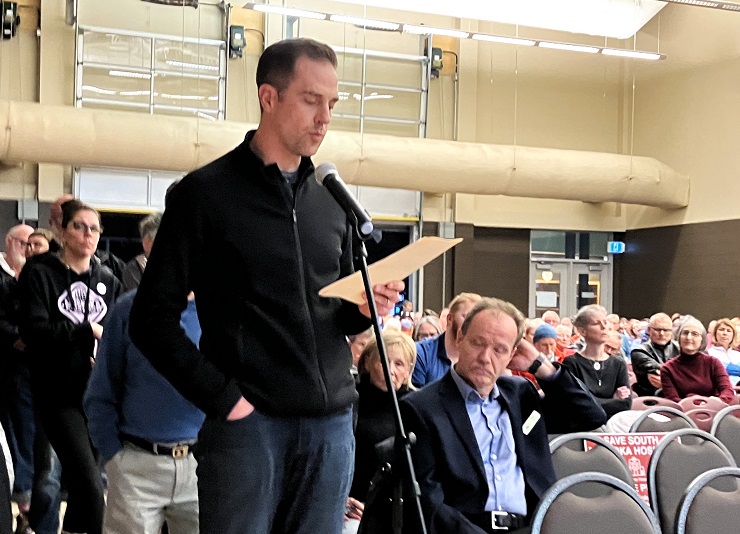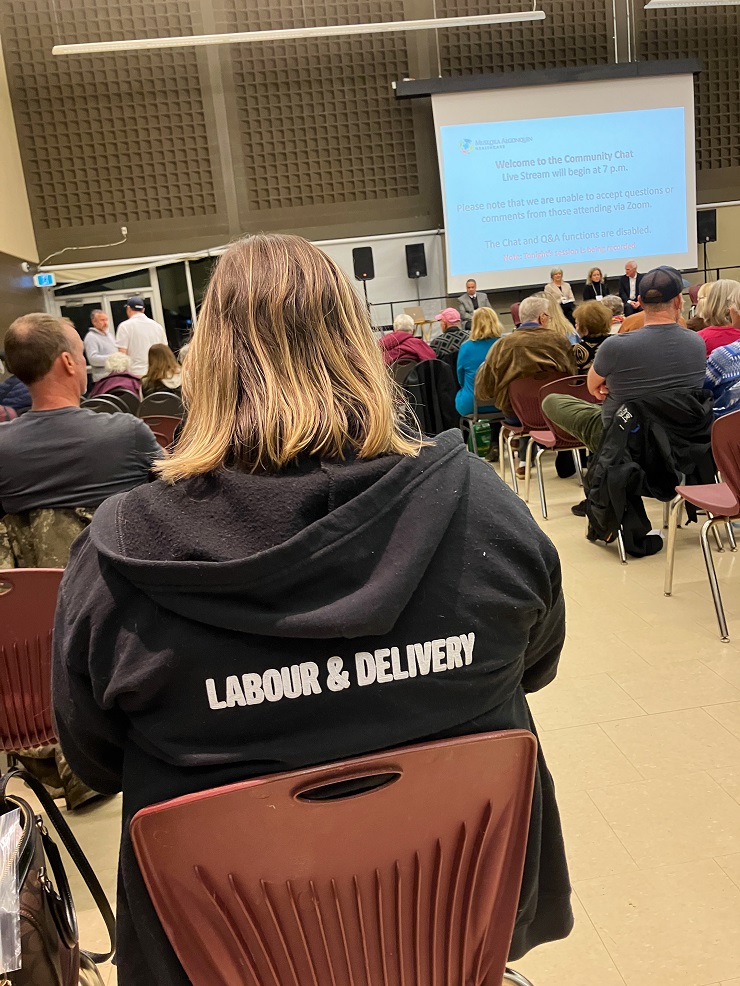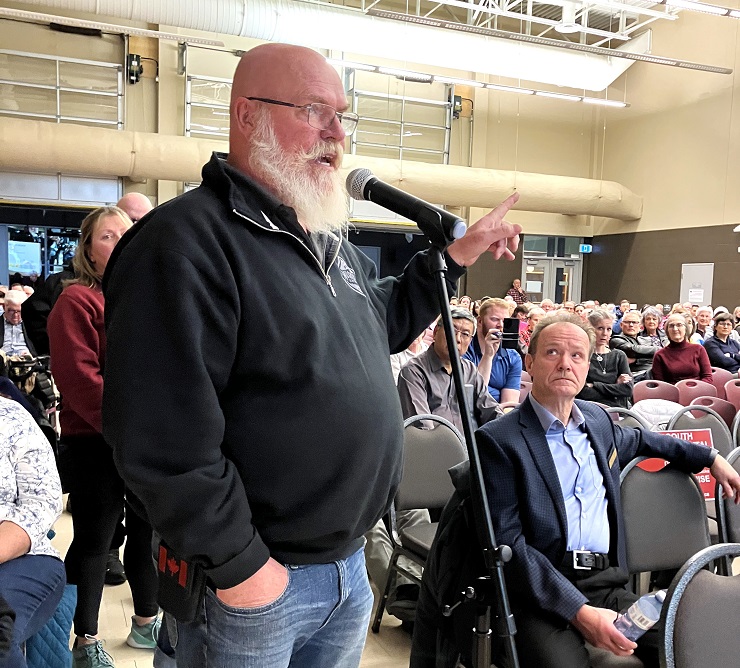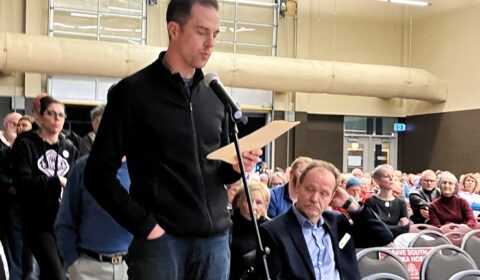HOSPITALS FEEDBACK ENDS WITH MORE CONCERNS AND UNANSWERED QUESTIONS
Mark Clairmont | MuskokaTODAY.com
BRACEBRIDGE — The ball’s back in MAHC’s court after its ninth hospitals model meeting, as they decide how to respond to public outcry about two unequal hospital sites in the coming months before submitting the “proposal” to the province.
Or whether they should alter it after hearing from residents and patients.
Doctor recruitment, paramedic dispatch and obstetric liability were among questions for Muskoka Algonquin Healthcare’s board last night as concerns mounted.
Round 2 had no knockout punch, but several body blows. A particular late knockdown floored the audience of some 350.
That exchange began when Michael O’Driscoll, a retired occupational therapist at SMMH, asked “the estimated cost of each site?”
Alasdair Smith, hospitals CFO, couldn’t say. “I don’t have the break down right now.”
“And you’re running the show?” O’Driscoll shot back.
Cheryl Harrison, CEO and president, added: “Does it matter how much money we’re spending on each site?”
She quickly sat down, no doubt regretting her interjection that drew one of the largest negative responses of another jam-packed showdown with her patients and public.

If last Tuesday’s first confrontation in Bracebridge was spirited, a week later the mood of the similar-sized crowd was only slightly less reserved as comments shouted from the floor remained relentless in the 100-minute Q&A.
Close to 30 people lined up at the single mic to speak. A half dozen ran out of time to speak by 9 p.m.
The entire evening, was like the other meetings, a hospitals 101 crash course in understanding how vital services work. A lot to absorb in nine two-hour sessions — supplemented by public reaction and comment.
Smith said the source of data for building projections came from Ministry of Finance figures as required for any redevelopment submissions and “consultants have used them consistently throughout the process.”
He said neither site in south Muskoka or Bracebridge are up to code and need to be replaced, prompting many to ask why they remain open if they are “substandard facilities.”
Lorraine Etler, of Bracebridge, was just one of many who noted older hospitals in Toronto remain open.
She went on to talk about doctors’ accusations of a MAHC gag order to “silence” them in Bracebridge along with and an alleged reprimand in Huntsville that revealed discussions and repercussions of the plans late last year, which led to a serious near ER Christmas closure at HDMH. And she said chief of staff Dr. Khaled Abdel-Razek “assured” her last week that wasn’t the case.
She said a Huntsville doctor has already resigned.

Abdel-Razek responded last night that the Huntsville reprimand letter wasn’t related to the model plan and that he couldn’t “comment on disciplinary factors that are related to confidential human resources matters.”
Etler also feared a reduction in the hospitals’ donations, asking if the two foundations shouldn’t be amalgamated to fund both sites.
The chief of staff was also asked about primary care in hospitals. He said eight of 10 patients admitted to MAHC now are under care of a hospitals physician.
And only 8 per cent of the 21,500 patients last year in each ER were admitted to hospital.
They account for more than 70 per cent of the acute care bed stays.
Thirty per cent of the existing patients are in permanent alternate level of care patients waiting to be moved back home or to LTCs.
He said 95 per cent of the surgical care patients do not require admittance to hospital.

Next to speak was Dr. Michael Mason, a Bracebridge family doctor and accredited hospitals physician, said he was also assistant program director for the Northern Ontario School of Medicine for rural family medicine residents program, where he oversees family physicians training in Parry Sound, Huntsville, Bracebridge and Gravenhurst.
He said NOSM is “one of the most sought-after, competitive rural teaching programs in the province. And in 2021 was awarded a provincial teaching award of excellence due to the overwhelming interest of medical students wanting to come here.”
Since NOSM opened in 2009, Mason said 20 doctors (about 10 in Huntsville and Bracebridge) have moved to Muskoka for jobs.
Mason said as of this year NOSM is in talks to provide students with a family medicine teaching unit, which would allow them to see their own patients — akin to having their own roster of patients that would allow more Muskokans without a family doctor.
“One other benefit,” he said, “is that of recruitment. And not just for family medicine jobs, but also hospital jobs. In fact the last three graduates of the program have decided to stay and work with us fulltime in south Muskoka. Dr. Cole Krensky, one of our hospitalists; Dr. Rachel Greer, one of our emergency doctors; and Dr. Jennifer Hammell, one of our family doctors.”
Mason said he has “confirmed with a NOSM program director that with south Muskoka only having 14 inpatient beds — and with the uncertainty of not knowing if we’re going to be the most responsible physicians of these patients — the family medicine teaching program in Bracebridge and Gravenhurst will likely dissolve.”
He added “comprehensive rural family medicine training, including clinic and inpatient medicine and pre-natal care and obstetrics is a cornerstone of rural family medicine and teaching.”
In a Zoom call last week with other family medicine directors across north-eastern and north-western Ontario, Mason said, that as of July 1 this year there are now plans to expand the number of first-year resident positions in Gravenhurst and Bracebridge.
“Which is great news for us.”

He said there is “a growing appetite among my colleagues also to take on NOSM residents for the two-year term. We also have a number of NOSM medical students showing up every year for their third year of training. And with potentially less preceptors and the elimination of inpatient medicine this program is likely in a state of flux.
“This is the program that I proudly graduated from in 2012 and I can say with certainty that without my eight months of medical training here in Bracebridge I would be practising elsewhere.
“Dr. (Kimberly) Forrester, Dr. (Sandi) Adamson, Dr. (Luke) Wu and Dr. (Jessica) Nairn are also by-products of this clerkship program.”
Those four local physicians, along with Mason, signed a letter opposing the new model.
“This is also timely to the Ford government’s announcement this past Friday to increase the number of medical education spots by 70 in northern Ontario, which would include south Muskoka because it falls within NOSM’s catchment.
“We know that the best recruitment is to train doctors locally. Recent data from NOSM shows that close to 45 per cent of residents will stay and work in the area that they train in.
“I firmly do not believe that having a new state of the art hospital will be enough to attract physicians and their families to Bracebridge.”
Mason says having sat on south Muskoka’s recruitment and retention committee when he first moved here “I understand first hand how challenging recruiting can be especially in rural Ontario. Not helping matters with regard to family medicine improvements is that fewer and fewer medical students are choosing family medicine as their choice for residency.
“So I implore you, to please reconsider the number of inpatient beds proposed for this model so we can keep medical education flourishing in the south.
“So the question for the senior team is knowing that recruitment is currently a problem for us: Is the termination of a medical teaching program concerning for you?
“And secondly, if this model with 14 inpatient beds and no obstetrical care is pushed through, what concrete plan do you have to insure recruitment is addressed with a glossy new hospital will not itself attract new recruits?”
Abdel-Razek addressed Mason’s comments by saying MAHC will be having more talks to discuss these “valid” concerns.
Regarding the issue of education, the chief of staff said “as an organization we are keen on investing in medical education….
“It will not be pushed through.”
And it will be one of the main topics discussed with doctors on February 20, he said.

Another concern was raised about ambulance off-load delays with fewer inpatient beds at South Muskoka Memorial hospital.
The speaker with dispatch experience said there are only eight paramedic vehicles on duty most of the year with two more added in the summer.
And that without more inpatient beds, even with 27 new ER beds to be added, that coverage will be stretched.
She also asked how would patients needing to go to Huntsville be transferred.
Presently Muskoka Paramedic Services covers from Novar down to Severn Bridge, and from Georgian Bay eastward to almost Carnarvan.
She said if paramedics are in off-load delay and can’t respond to 911 calls, “How serious and how sad is that?”
That would leave MacTier, Port Carling and Baysville short of coverage, as paramedics and hospital staff have to escort patients to Huntsville.
“Do not make this situation happen.”
She asked “what is the contingency plan when your transportation system fails?”
Melissa Bilodeau, chief nursing executive, said “we are working on that.”
She said MAHC is in talks with MPS about “how do we get to advanced care paramedics,” which she added is “probably the next step for our communities.”
“We know that transfers from site to site for stable patients won’t be handled by MPS, because we don’t have the capacity. We’re going to have to find a solution for that.”
MAHC has had discussions with Quinte Health about their transportation system.
Biliodeau also said discussions with non-urgent transfer providers show they provide “integral” staff.
Harrison said MAHC hasn’t done the “operational planning for what it would cost. We’re in a concept mode right now. And the $15 million (the province gave) you refer to, we haven’t spent it all. We just got it two years ago. … We’ve got to design these buildings, we’ve got a lot more work to do using that $15 million.”

Tom Young, of Bracebridge, who said he was “the poster boy for this hospital for about seven years,” talked about the great care he received with his cancer treatment.
“The hospital is very special to me. Because Dr. (Roshi) Gupta and every person in the hospital, they saved my life.”
He said Dr. Gupta visited me every day I was in there, which was very comforting…. He knows me better inside than out.”
Young, a former Ontario NDP candidate, said his family and family doctor Marty O’Shaughnessy, also visited him every day. “Which was very comforting.”
But Young said: “If I have to go to Huntsville after my surgery here, they’re not going to visit me every day up there. I know that.
“I think the problem here — and I’m trying to be very respectful as a board — for a long time many people thought you were working on two full-service hospitals. And then all of a sudden two, three weeks ago, I don’t know, it came out on Facebook this plan. No one was expecting this whatsoever.”
He said a couple years ago the province was promising equal hospitals.
“Now we’ve got this.
“I’m glad you call this a proposal. Yes there’s a lot more work. I have no problem with a specialty service once in a while.
Young said he’s been to Barrie for cancer follow-ups and Orillia for chemo.
“And I understand the Stroke Centre could be in Huntsville and that’s fine.
“But the two development hospitals the way you’ve got them now are just way too far apart, way too far apart”
“You’ve got to go back to the drawing board in my opinion and get them closer together. And I would highly encourage you to work with these two gentlemen to make it happen” he said pointing to Muskoka Royale promoters. “They’ve got the coin by the sounds of it. Work with them. I know there’s infrastructure out to their property because Muskoka Brewery has water and sewer. And that’s right across from the old turkey farm.”
MORE ON THIS STORY LATER …
EMAIL: news@muskokatoday.com
30 years of TRUSTED ‘Local Online Journalism’
Twitter: @muskokatoday, Facebook: mclairmont1
Leave comments at end of story
SUBSCRIBE for $25 by e-transferring to news@muskokatoday.com
Mail cheque to MuskokaTODAY.com Box 34 Gravenhurst, Ont. P1P 1T5
And include your email address to get stories sent to your inbox
